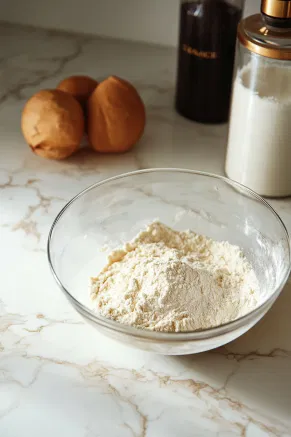This classic British dessert is the epitome of comfort food, perfect for a cozy evening or a holiday treat. A steamed suet pudding studded with dried currants or raisins, Traditional Spotted Dick is a rich and indulgent dessert with a wonderfully dense texture and slightly sweet flavor.
The name might raise a few eyebrows, but once you taste it, you’ll be hooked. Served warm, it’s the perfect indulgence to enjoy with your favorite toppings.
Serve your Traditional Spotted Dick with a generous dollop of Whipped Cream for an extra creamy touch, or drizzle some Caramel Sauce over the top to add a sweet, buttery richness that will take this dessert to the next level. Whether you’re hosting a dinner party or simply enjoying a treat at home, this classic dessert pairs perfectly with these indulgent toppings for a comforting finish.
Why You’ll Love This Traditional Spotted Dick?

- Rich and Comforting: The warm, dense texture of the suet pudding, with plump dried fruits, makes it a perfect treat for cold weather.
- A British Classic: The nostalgia and tradition of this dessert make it a great choice for holiday dinners or special occasions.

Spotted Dick Recipe
Equipment
- Large stockpot
- 1.6-liter pudding mold with a lid
- Metal cookie cutters, towel, or tin foil (for bottom of the pot)
- Food processor
- Large mixing bowl
- Plate for weighting the pudding mold
- Measuring cups and spoons
Ingredients
- 2 cups all-purpose flour
- 2 teaspoons baking powder
- 1/4 teaspoon salt
- 5 ounces shredded beef suet highly recommended for best results, but can substitute 10 tablespoons chilled butter, diced
- 2/3 cup caster sugar or regular granulated sugar
- 1 cup dried currants
- 3/4 cup milk
- 2 teaspoons quality vanilla extract
- Zest of one large lemon
- English Custard Sauce for serving
Instructions
- Prepare the Pot and Mold: Place metal cookie cutters or a towel in the bottom of a large stockpot to elevate the pudding mold. Add water and bring to a boil. Grease a 1.6-liter pudding mold.

- Mix Dry Ingredients: In a food processor, pulse flour, baking powder, salt, suet (or diced butter), and sugar until the mixture resembles coarse sand. Transfer to a large bowl.

- Combine Wet Ingredients: Stir in milk, lemon zest, vanilla extract, and currants until the batter is combined.

- Fill the Mold: Scoop the batter into the greased pudding mold and secure the lid tightly.

- Steam the Pudding: Lower the pudding mold into the boiling water, ensuring water reaches halfway up the mold. Reduce heat to a simmer. Steam for 90 minutes (or 3-4 hours if using suet). Check water periodically, adding more if needed.

- Cool and Serve: Remove the mold from the pot and let it sit for 15 minutes. Invert onto a plate, slice into wedges, and serve warm with English custard sauce.

Nutrition Info:
| Nutrition | Value |
|---|---|
| Calories | 498 kcal |
| Cholesterol | 53 g |
| Sodium | 282 g |
| Fat | 20 g |
| Protein | 6 g |
| Fibre | 2 g |
Tips You Must Be Mindful Of!
- Suet vs. Butter: While suet is the traditional choice, it imparts a unique texture and flavor to the pudding that’s hard to replicate with butter. However, if you do substitute butter, be sure to use chilled butter and dice it finely to mimic the crumbly texture of suet. The colder the butter, the better it will cut into the dry ingredients, creating the right consistency.
- Currants: Currants can sometimes be too dry or hard, so soak them in a little warm water or tea before mixing them into the batter. This not only helps them soften but also ensures they distribute more evenly throughout the pudding.
- Greasing the Mold: Grease the pudding mold generously with butter and line it with parchment paper. This gives the pudding a smooth release and prevents any batter from sticking to the sides. If you’re unsure, lining it with parchment and then greasing the paper offers extra security.
- Water Level During Steaming: When you’re steaming the pudding, ensure the water is at a steady simmer rather than a rolling boil, which can cause uneven cooking. Keep the water level consistent, ideally halfway up the pudding mold, and top it off as necessary. If you’re steaming for several hours, be sure to check the water every hour or so to avoid drying out the pudding.
- Lemon Zest: Don’t skip the lemon zest—it adds a bright, aromatic touch that balances the richness of the suet and custard. If you want to enhance the citrus notes further, you can add a dash of lemon juice to the batter or in the custard sauce for extra depth.
- Resting After Steaming: Letting the pudding rest in the mold for 15 minutes before inverting it helps the texture settle. It also ensures that any residual steam doesn’t cause the pudding to collapse or become too soft upon removal.
- Serving Suggestion: For an added touch of luxury, you can infuse your English custard sauce with vanilla bean or a splash of brandy to complement the flavors of the pudding.
- Steam Time Variations: If you prefer a denser, more moist pudding, opt for the longer steam time, especially if you’re using suet. The slow, gentle steam helps the pudding develop a rich, deep flavor. However, if you’re in a rush, a shorter steaming time (around 90 minutes) will still yield great results.
These subtle tweaks will ensure your steamed suet pudding has the perfect texture and flavor, while still respecting its traditional roots. Enjoy each comforting bite with that rich, creamy custard.




